털코뿔소
"오늘의AI위키"의 AI를 통해 더욱 풍부하고 폭넓은 지식 경험을 누리세요.
1. 개요
털코뿔소는 코엘로돈타속에 속하는 멸종된 코뿔소 종이다. 이 종은 약 370만 년 전 티베트에서 처음 나타났으며, 플라이스토세 동안 시베리아, 몽골, 중국, 유럽 등 북부 유라시아 전역에 널리 분포했다. 털코뿔소는 현존하는 수마트라코뿔소와 가장 가까운 친척이며, 키는 1.45~1.6m, 몸길이는 3.2~3.6m, 몸무게는 최대 2톤에 달하는 대형 초식 동물이었다. 이들은 두 개의 뿔과 두꺼운 털을 가지고 있었으며, 매머드 스텝에서 풀과 사초과 식물을 주로 섭취했다. 털코뿔소는 마지막 빙하기 이후 기원전 1만 4천 년에서 1만 4천 2백 년 사이에 멸종했으며, 기후 변화, 서식지 감소, 인간의 사냥 등이 복합적으로 작용한 것으로 추정된다. 냉동 표본이 다수 발견되어 연구에 활용되고 있다.
더 읽어볼만한 페이지
- 고대 코뿔소 - 엘라스모테리움
엘라스모테리움은 유라시아 지역에서 발견된 멸종된 코뿔소의 한 속으로, 큰 뿔과 초원 환경에 적응한 특징을 가지며, 약 3만 6천 년 전에 멸종되었다. - 1799년 기재된 화석 분류군 - 털매머드
털매머드는 플라이스토세 후기부터 홀로세에 걸쳐 유라시아와 북아메리카에 서식했으며 털로 덮인 몸과 긴 상아를 가진 빙하기 대표 동물로, 아시아코끼리와 가장 가까운 친척 관계이며, 구석기 시대 인류와 공존하여 고생물학적 연구와 복원 시도가 이루어지고 있다. - 1799년 기재된 화석 분류군 - 마스토돈
마스토돈은 멸종된 장비목의 한 속으로, 젖꼭지 모양의 이빨을 가졌으며, 북미에서 널리 분포했던 맘무트 아메리카눔을 포함하여 숲 환경을 선호하고 초식 생활을 하였으며, 멸종 시기는 약 75,000년 전으로 추정된다.
| 털코뿔소 - [생물]에 관한 문서 | |
|---|---|
| 기본 정보 | |
 | |
| 학명 | Coelodonta antiquitatis |
| 명명자 | Blumenbach, 1799 |
| 이명 | Rhinoceros lenenesis Pallas Rhinoceros antiquitatis Blumenbach Rhinoceros tichorhinus Fischer. |
| 아종 | C. a. praecursor Guérin, 1980 C. a. antiquitatis Guérin, 1980 |
| 분류 | |
| 계 | 동물계 |
| 문 | 척삭동물문 |
| 강 | 포유강 |
| 목 | 기제목 Perissodactyla |
| 과 | 코뿔소과 Rhinocerotidae |
| 속 | Coelodonta |
| 종 | 케브카사이 (C. antiquitatis) |
| 생존 시기 | |
| 지질 시대 | 중기 플라이스토세 - 후기 플라이스토세 |
2. 분류학
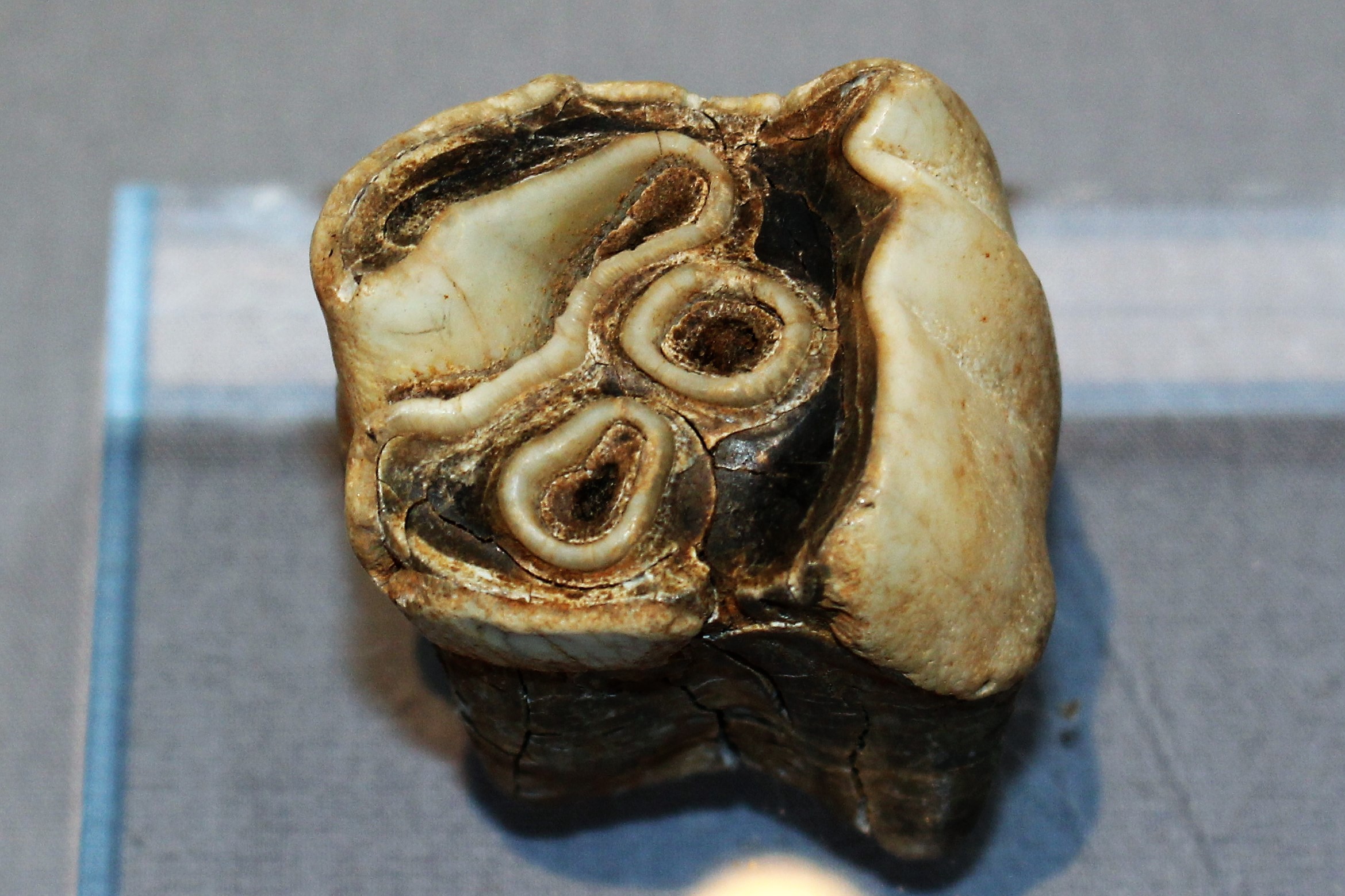
털코뿔소 유적은 학계에 정식으로 보고되기 훨씬 이전부터 발견되었으며, 때로는 신화 속 동물의 기원으로 여겨지기도 했다. 예를 들어, 시베리아 원주민들은 발견된 코뿔소의 뿔을 거대한 새의 발톱으로 생각했다.[89] 1335년 오스트리아 클라겐푸르트에서 발견된 털코뿔소 두개골은 용의 것으로 여겨졌고,[90] 1590년에는 이 지역 린트부름 동상의 머리 부분 모델이 되기도 했다.[91] 고트힐프 하인리히 폰 슈베르트는 이 동물을 '고대의 그리핀'이라는 뜻의 ''Gryphus antiquitatis''로 분류하기도 했다.[92]
털코뿔소에 대한 최초의 과학적 기록 중 하나는 1769년 자연주의자 페터 지몬 팔라스가 남긴 것이다. 그는 시베리아 탐험 중 영구 동토층에서 두개골과 뿔 두 개를 발견하여 보고했다.[93] 1772년, 팔라스는 이르쿠츠크 지역 주민들로부터 털코뿔소의 머리와 다리 두 개를 얻어,[94] 레나강의 이름을 따 ''Rhinoceros lenenesis''라는 학명을 붙였다.[95] 이후 1799년, 요한 프리드리히 블루멘바흐는 괴팅겐 대학교 소장품의 털코뿔소 뼈를 연구하여 ''Rhinoceros antiquitatis''('옛 코뿔소'라는 의미)라는 학명을 제안했다.[96]
최종적으로 1831년, 지질학자 하인리히 게오르크 브론은 털코뿔소의 이빨 구조가 현생 코뿔소속과 다르다는 점에 주목하여 새로운 털코뿔소속으로 분류했다.[97] 속명 ''Coelodonta''는 그리스어로 '속이 비어 있다'는 뜻의 코일로스(κοιλος, ''koilos'')와 '이빨'을 뜻하는 오두스(ὀδούς, ''odoús'')를 합친 것으로, 어금니의 깊게 파인 구조에서 유래했다.[98][99] 이에 따라 털코뿔소의 학명은 '고대의 속이 빈 이빨'이라는 의미의 ''Coelodonta antiquitatis''로 확정되었다.[100]
2. 1. 진화
털코뿔소는 털코뿔소속Coelodonta|코엘로돈타la의 가장 마지막에 나타난 종이다.[15] 털코뿔소속과 현존하는 가장 가까운 친척은 수마트라코뿔소이며, 멸종된 스테파노리누스속Stephanorhinus|스테파노리누스la과도 밀접한 관련이 있다.[14] 게놈 데이터 분석에 따르면, 털코뿔소속의 조상은 약 940만 년 전에 수마트라코뿔소의 조상과 갈라졌으며, 약 550만 년 전에 스테파노리누스속과 분기된 것으로 추정된다.[14]가장 오래된 것으로 알려진 털코뿔소속 종인 코엘로돈타 티베타나Coelodonta thibetana|코엘로돈타 티베타나la는 약 370만 년 전 티베트의 플라이오세 지층에서 발견되었다.[16] 이 속은 초기 플라이스토세 동안 시베리아, 몽골, 중국 등지에 서식했다. 털코뿔소는 중국에서 초기 중기 플라이스토세에 처음 등장했으며, 유럽에서 발견된 가장 오래된 털코뿔소 유해는 약 45만 년 전의 것으로, 이 지역에 존재했던 유일한 털코뿔소속 종이었다.[17][18]
털코뿔소는 중기 플라이스토세의 ''C. a. praecursor''와 후기 플라이스토세의 ''C. a. antiquitatis''라는 두 연대종 아종으로 나뉜다.[1] 미토콘드리아 게놈 분석 결과, 후기 플라이스토세 털코뿔소의 마지막 공통 미토콘드리아 조상은 약 57만 년 전에 살았던 것으로 추정된다.[19]
3. 형태
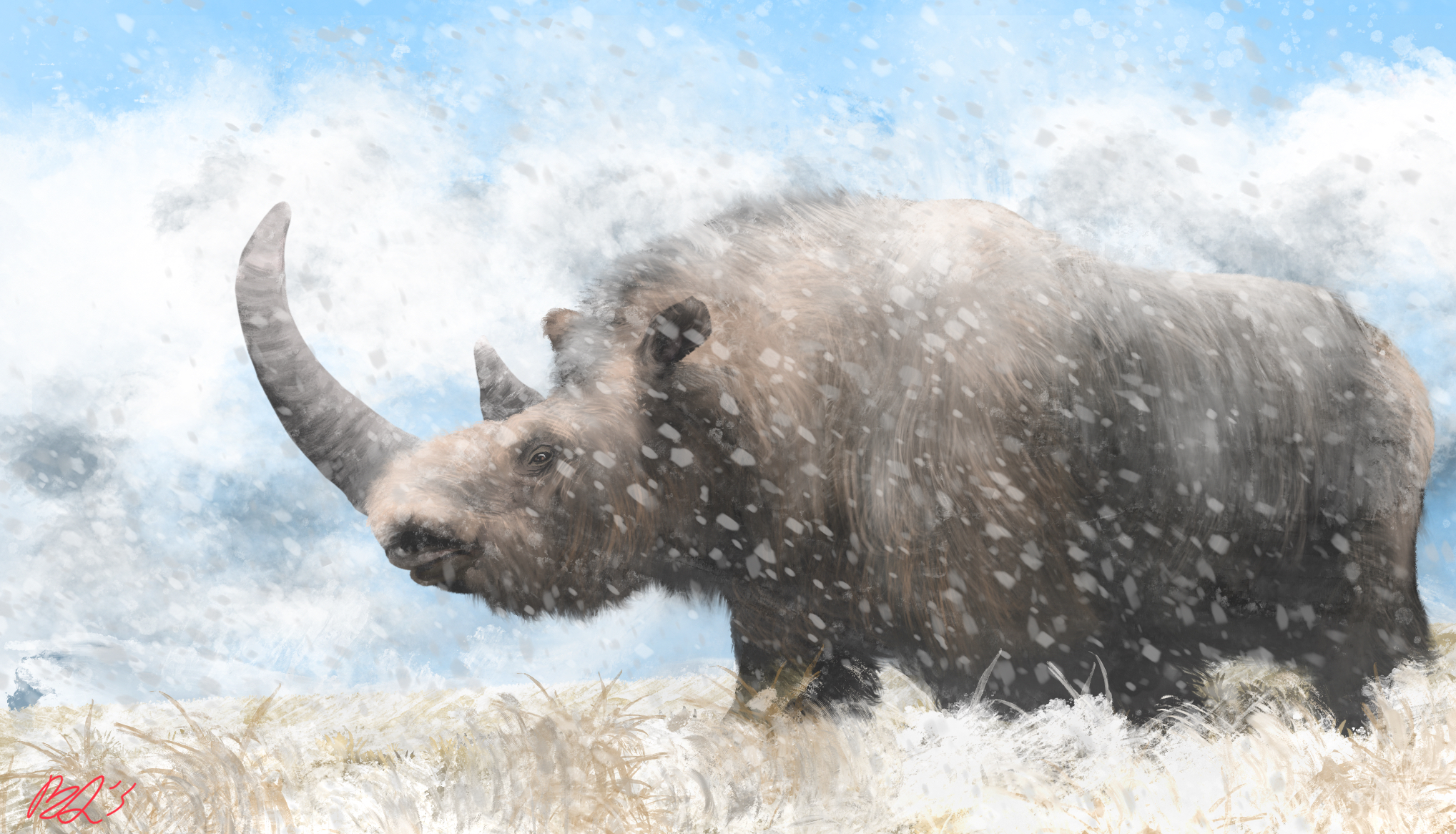
성체 털코뿔소는 일반적으로 머리부터 꼬리까지 몸길이가 약 3.2m에서 3.6m 사이였고, 어깨 높이는 약 1.45m에서 1.6m 사이였으며, 몸무게는 최대 1.5ton에서 2ton에 달했다.[103][104] 일부 자료에서는 이 종의 몸무게가 최대 2.4ton에서 2.9ton까지 나갔다고 추정하기도 한다.[101][102] 이는 현존하는 가장 큰 코뿔소 종인 흰코뿔소와 비슷한 크기이다.[103][104]
수컷과 암컷 모두 케라틴으로 이루어진 두 개의 뿔을 가지고 있었는데, 하나는 길게 앞으로 뻗어 있었고 다른 하나는 눈 사이에 있는 작은 뿔이었다.[105] 25~35세 개체의 경우 앞쪽 뿔의 길이는 약 1m에서 1.35m 정도였고, 뒤쪽 뿔의 길이는 최대 47.5cm였다. 현대 코뿔소와 달리 큰 앞뿔은 단면이 평평한 경우가 많았으며, 뿔의 마모 형태로 보아 풀을 먹을 때 눈을 치우는 용도로 사용했을 가능성이 제기된다.[107]
다른 코뿔소에 비해 털코뿔소는 머리와 몸통이 길고 다리가 짧았다. 어깨에는 거대한 앞뿔을 지탱하는 강력한 근육으로 이루어진 혹이 솟아 있었다. 이 혹은 매머드 스텝의 혹독한 겨울 동안 생존에 필요한 지방을 저장하는 역할도 했다.[108]
냉동 상태로 발견된 표본을 통해 털코뿔소의 몸이 길고 굵은 적갈색 털로 덮여 있었음을 알 수 있다. 특히 어깨와 목 부분의 털이 가장 두꺼웠으며, 긴 겉털 아래에는 빽빽한 솜털이 있었다. 다리는 비교적 짧은 털로 덮여 있어 눈이 달라붙는 것을 막았다.[108] 꼬리 길이는 약 45cm에서 50cm 정도였고, 끝에는 거친 털이 술처럼 나 있었다.[109] 암컷은 두 개의 젖꼭지를 가지고 있었다.[89]
털코뿔소는 추운 환경에 적응하기 위해 신체 표면적을 줄이고 열 손실을 최소화하는 여러 특징을 보였다. 귀의 길이는 24cm를 넘지 않았는데, 이는 더운 기후에 사는 코뿔소의 귀(약 30cm)보다 작다. 꼬리 또한 상대적으로 짧았다. 피부는 두꺼웠으며, 특히 가슴과 어깨 부분은 두께가 5mm에서 15mm에 달했다.[110]
3. 1. 두개골 및 치아
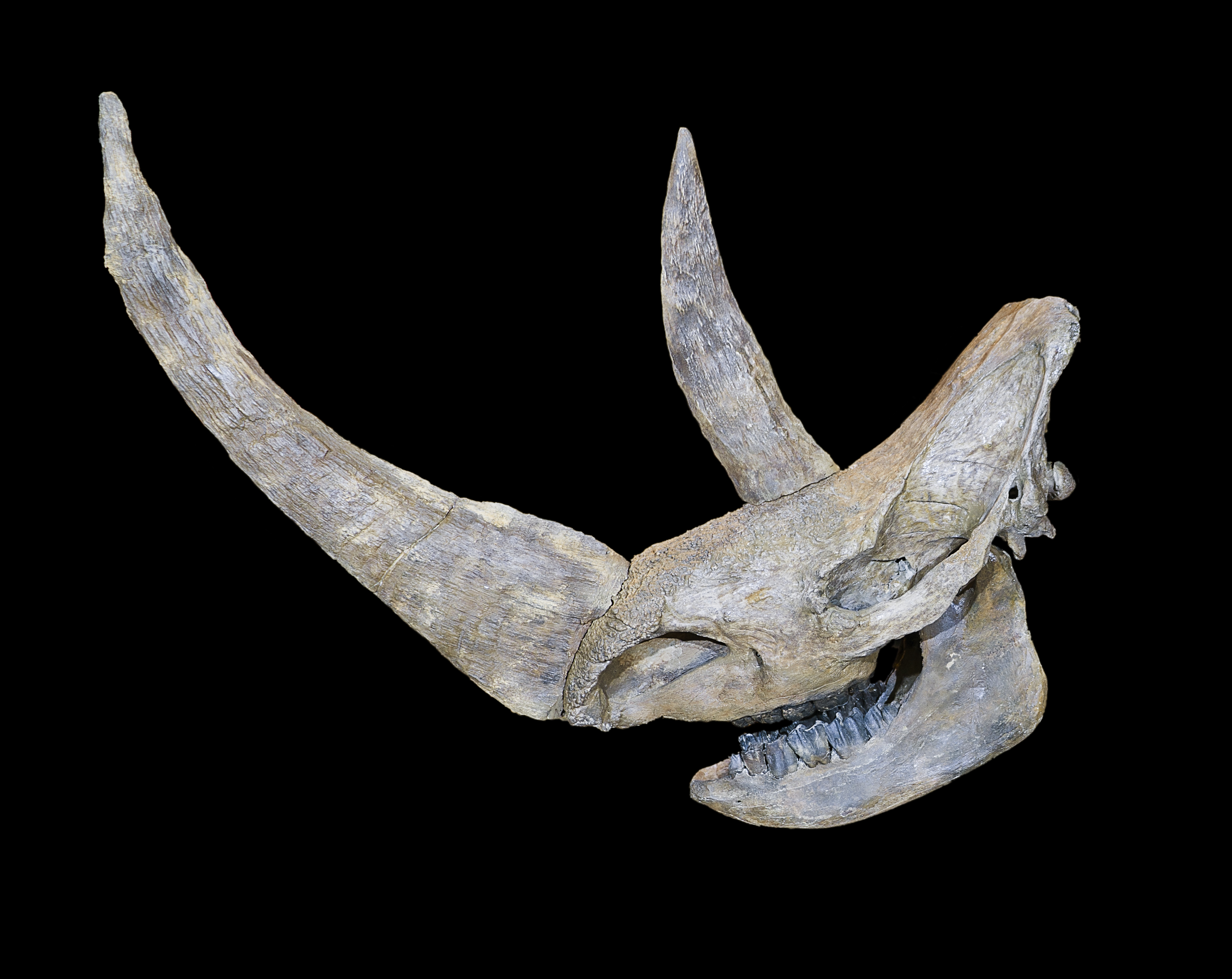
두개골의 길이는 약 70cm에서 90cm였다. 이는 다른 코뿔소들보다 길었으며, 머리가 아래쪽으로 기울어진 깊은 형태를 이루었는데, 이는 화석 친척인 ''스테파노리누스 헤미토에쿠스''와 ''엘라스모테리움'' 그리고 현존하는 흰코뿔소와 유사하다.[36] 긴 후두골에 붙은 강력한 근육이 목덜미를 형성하고 거대한 두개골을 지탱했다. 거대한 아래턱은 최대 길이 60cm, 높이 10cm에 달했다.
털코뿔소의 치아는 법랑질이 두껍고 내부 공간이 열려 있었다. 다른 코뿔소들과 마찬가지로 성체는 절치(앞니)가 없었다.[29] 위턱과 아래턱 모두에 소구치 3개와 대구치 3개가 있었다. 어금니는 높고 넓었으며 두꺼운 시멘트질로 덮여 있었다.[11]
털코뿔소의 비중격은 현생 코뿔소와 달리 골화되었다. 이는 특히 성체 수컷에게서 흔하게 나타나는 특징이었다. 이러한 적응은 코뿔소가 두꺼운 눈 속에서 풀을 뜯을 때 뿔과 얼굴에 가해지는 강한 압력의 결과로 진화했을 가능성이 높다.[35] 이 코뿔소만의 독특한 특징으로, 비골은 상악골과 융합되어 있었는데, 이는 오래된 ''코엘로돈타'' 종이나 현생 코뿔소에서는 볼 수 없는 특징이다.[28] 이러한 골화는 그리스어 τειχος (teikhos, "벽"), ῥις (ῥιν-) (rhis (rhin-), "코")에서 유래한 이명 종명 ''티코리누스''(τειχόρρινος|테이코르리노스grc)의 어원이 되었다.
4. 고생물학

털코뿔소의 생활사는 현대 코뿔소와 유사했던 것으로 보인다. 젖니(유치)에 대한 연구 결과, 털코뿔소 개체는 흰코뿔소와 검은코뿔소와 비슷하게 발달했다는 사실이 밝혀졌다.[111][29] 암컷에게 두 개의 젖꼭지가 있었다는 점은 2~3년마다 한 마리, 드물게는 두 마리의 새끼를 낳아 길렀음을 시사한다.[112][30]
거대한 뿔과 몸집 덕분에 성체 털코뿔소는 천적이 거의 없었을 것으로 추정된다. 하지만 어린 개체는 동굴하이에나나 동굴사자와 같은 포식자의 공격을 받았을 수 있다. 실제로 고양이과 동물의 공격 흔적이 남은 두개골 화석이 발견되기도 했지만, 이 개체는 공격에서 살아남아 성체까지 성장한 것으로 보인다.[115][33] 또한, 동굴하이에나의 굴에서 털코뿔소의 유해가 종종 발견되는데,[113][31] 이는 하이에나가 이미 죽은 코뿔소의 사체를 먹었음을 보여주는 증거일 가능성이 높다.[114][32]
털코뿔소는 뿔을 다양한 용도로 사용했을 것으로 생각된다. 동굴벽화에도 묘사된 것처럼, 같은 종끼리 싸우는 데 사용했을 뿐만 아니라, 겨울철 눈을 헤치고 땅속의 풀을 찾아 먹는 데에도 활용했을 수 있다.[110][27] 짝을 유인하는 데 사용되었을 가능성도 제기된다. 현대 코뿔소처럼 털코뿔소 수컷도 영역을 가지고 있었으며, 특히 발정기에는 경쟁자로부터 자신의 영역을 지키려 했을 것이다. 화석으로 발견된 두개골 중에는 다른 코뿔소의 앞뿔에 의해 손상된 흔적이 남아있는 경우도 있으며,[115][33] 아래턱뼈나 등쪽 갈비뼈에서 부러졌다가 다시 붙은 흔적이 발견되기도 하는데, 이 역시 싸움의 결과로 추정된다.[116][34] 현대 코뿔소와 비교했을 때 털코뿔소에게서 종내 경쟁의 흔적이 더 자주 나타나는 이유는, 마지막 빙하기 동안 급격한 기후 변화를 겪으며 다른 대형 초식동물과의 생존 경쟁이 심화되었기 때문일 수 있다.[117][35]
털코뿔소는 주로 매머드 스텝 지역에 자라는 풀과 사초를 먹고 살았다. 길고 비스듬하게 기울어진 머리와 아래쪽을 향한 자세, 그리고 치아 구조는 모두 땅에 낮게 자라는 풀을 뜯어 먹기에 적합한 형태였다.[106][118] 특히 흰코뿔소처럼 넓은 윗입술을 가지고 있어 땅에 붙어 자라는 풀을 효율적으로 뜯을 수 있었다. 영국 스태퍼드셔주 화이트무어 헤이(Whitemoor Haye)에서 발견된 잘 보존된 털코뿔소의 두개골, 아래턱뼈, 치아에 대한 생체역학적 분석 결과, 풀을 뜯어 먹는 식성에 유리한 근육 및 치아 특징이 확인되었다.[89] 특히, 측두근과 목 근육이 크게 발달한 것은 땅에서 먹이를 뜯어 올릴 때 발생하는 강한 힘에 저항하기 위한 것으로 보이며, 큰 종격동(가슴 안쪽 공간)의 존재 역시 이러한 추정을 뒷받침한다.[119]
4. 1. 서식지 및 분포
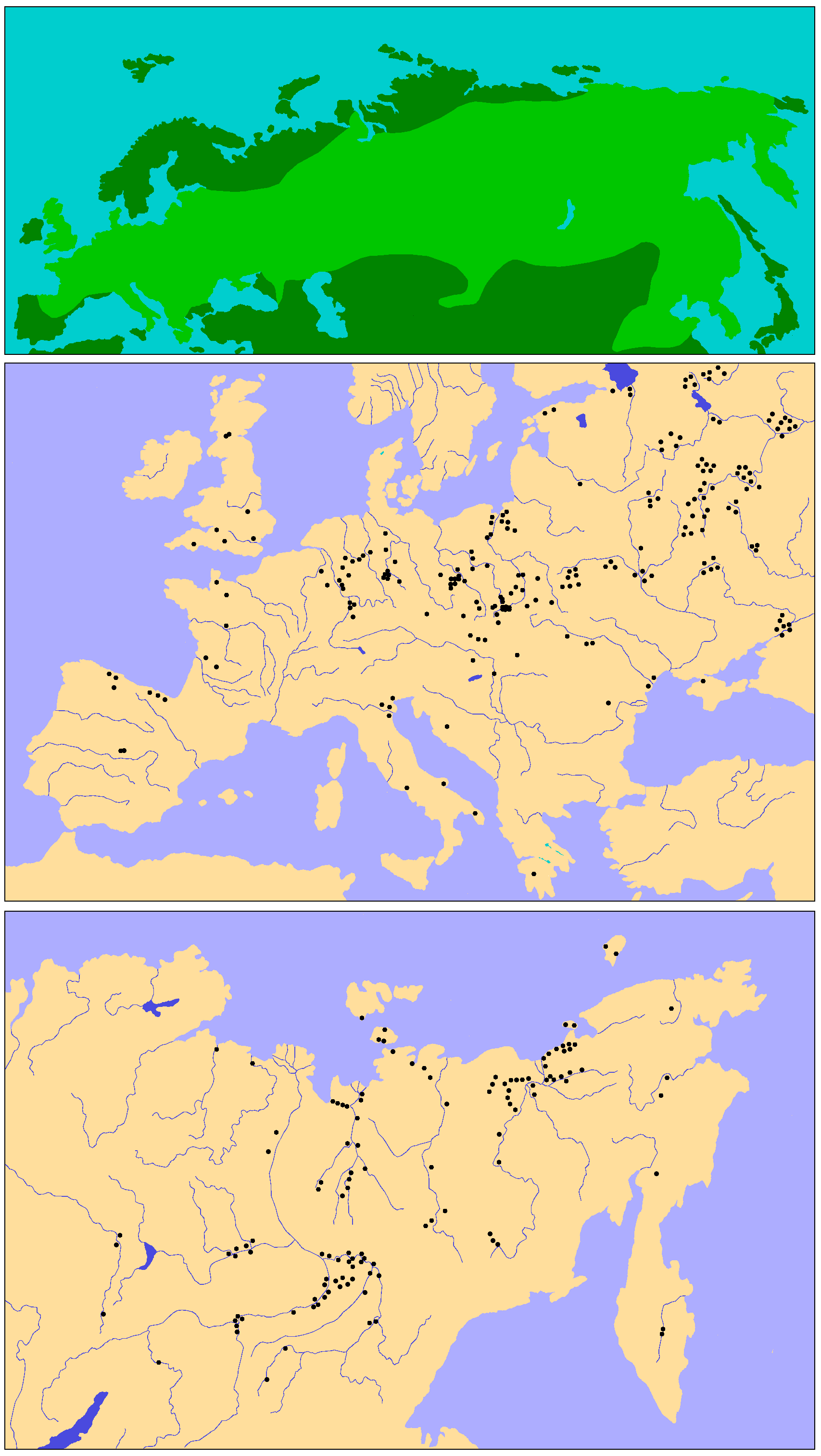
털코뿔소는 주로 저지대, 고원, 그리고 건조하거나 메마른 기후의 강 계곡에서 서식했으며, 기후가 온화한 시기에는 고지대로 이동하기도 했다.[49] 폭설과 가파른 지형 때문에 산맥은 피했다.[49] 주요 서식지는 넓은 초원과 관목으로 덮인 광활한 개방형 지형인 매머드 스텝이었다. 이곳에서 털코뿔소는 털매머드, 거대 사슴, 순록, 사이가 영양, 들소와 같은 다른 대형 초식 동물들과 함께 살았으며, 이 동물군을 ''맘무투스''-''켈로돈타'' 동물군이라고 부른다.[44] 넓은 분포 범위 덕분에 일부 지역에서는 다른 코뿔소 종인 ''스테파노리누스''[25]나 ''엘라스모테리움''[45]과 공존하기도 했다.
약 13만 년 전 리스 빙하기 말엽에는 유럽 대부분, 동유럽 평원, 시베리아, 몽골 고원에 걸쳐 북부 유라시아 전역에 서식했으며, 북위 72°에서 남위 33°N까지 극단적인 지역에 분포했다. 뉴 시베리아 제도에서도 화석이 발견되었다.[27][46] 매우 따뜻했던 엠 간빙기 동안에는 폴란드와 같은 온대 지역까지 분포 범위가 확장되기도 했다.[47] 이는 어떤 코뿔소 종보다도 가장 넓은 서식 범위였다.[48]
마지막 빙하기 동안에는 아시아와 북아메리카를 연결했던 베링 육교를 건너지 않은 것으로 보이며, 가장 동쪽으로는 추코트카 반도에서 발견된다.[27] 북아메리카 대륙에서는 화석이 발견되지 않았는데, 이는 같은 시기에 서식했던 털매머드와는 다른 점이다. 그 이유는 불명확하지만, 유콘 지역의 낮은 풀 밀도와 적합한 서식지 부족, 그리고 차가운 육교에서 다른 대형 초식 동물들과의 경쟁 때문일 것이다.[49]
5. 인간과의 관계
털코뿔소는 몸통 길이가 약 4m에 달하고 코에는 두 개의 뿔이 있었으며, 특히 앞쪽 뿔은 나이 든 수컷의 경우 1m가 넘기도 했다. 이러한 모습은 구석기 시대의 동굴 벽화에도 그려져 있다. 털코뿔소는 영국에서 시베리아 동부에 이르는 넓은 지역, 특히 툰드라 지대에 서식했다.
시베리아 북동부에서는 약 3만 년 전에 이주해 온 인류와 수천 년 동안 같은 환경에서 공존했던 것으로 보인다.[88] 그러나 최종 빙기가 끝날 무렵 개체 수가 급격히 감소하여 결국 멸종했다.[88]
5. 1. 사냥
초기 인류가 털코뿔소를 사냥하거나 청소 동물로 이용했음을 보여주는 흔적은 동물 뼈에 남은 자국에서 찾을 수 있다. 한 표본에서는 인간의 무기로 인한 부상이 확인되었는데, 날카로운 물체로 인한 상처가 어깨와 허벅지에 자국을 남겼으며, 시체 근처에서는 보존된 창이 발견되기도 했다.후기 중기 구석기 시대의 최후 빙하기 초기 단계에 해당하는 몇몇 유적지, 예를 들어 오스트리아의 구데누스 동굴[54]이나 독일 작센-안할트 주의 쾨니히자우에 야외 유적지[55]에서는 깊은 자국이 있는 털코뿔소 뼈가 발견되었다. 이는 당시 인류가 영양가 있는 골수를 추출하기 위해 뼈를 처리했음을 보여준다.[56]
5. 2. 고대 예술
후기 구석기 시대의 많은 동굴벽화에는 털코뿔소가 그려져 있다. 이 동물의 특징적인 모습, 즉 솟은 등과 혹, 그리고 낮게 드리운 머리가 두드러지게 그려져 있다. 두 개의 곡선은 귀를 나타내며, 뿔은 길게 굽은 모양으로 그려져 있고 경우에 따라 털도 표현되어 있다. 많은 그림에서 몸통을 가로지르는 검은 띠가 보인다.[120][61]프랑스의 쇼베 동굴이 발견되기 전까지 약 20점의 구석기 시대 털코뿔소 그림이 알려져 있었다.[61] 쇼베 동굴의 그림들은 3만 1천 년 이상 된 것으로 추정되며, 아우리냐크 문화 시대의 것으로 보인다.[27] 이 그림들은 동굴 벽에 조각되거나 붉은색 또는 검은색으로 그려져 있다. 한 장면에는 뿔로 서로 싸우는 두 마리의 코뿔소가 묘사되어 있다.[62]
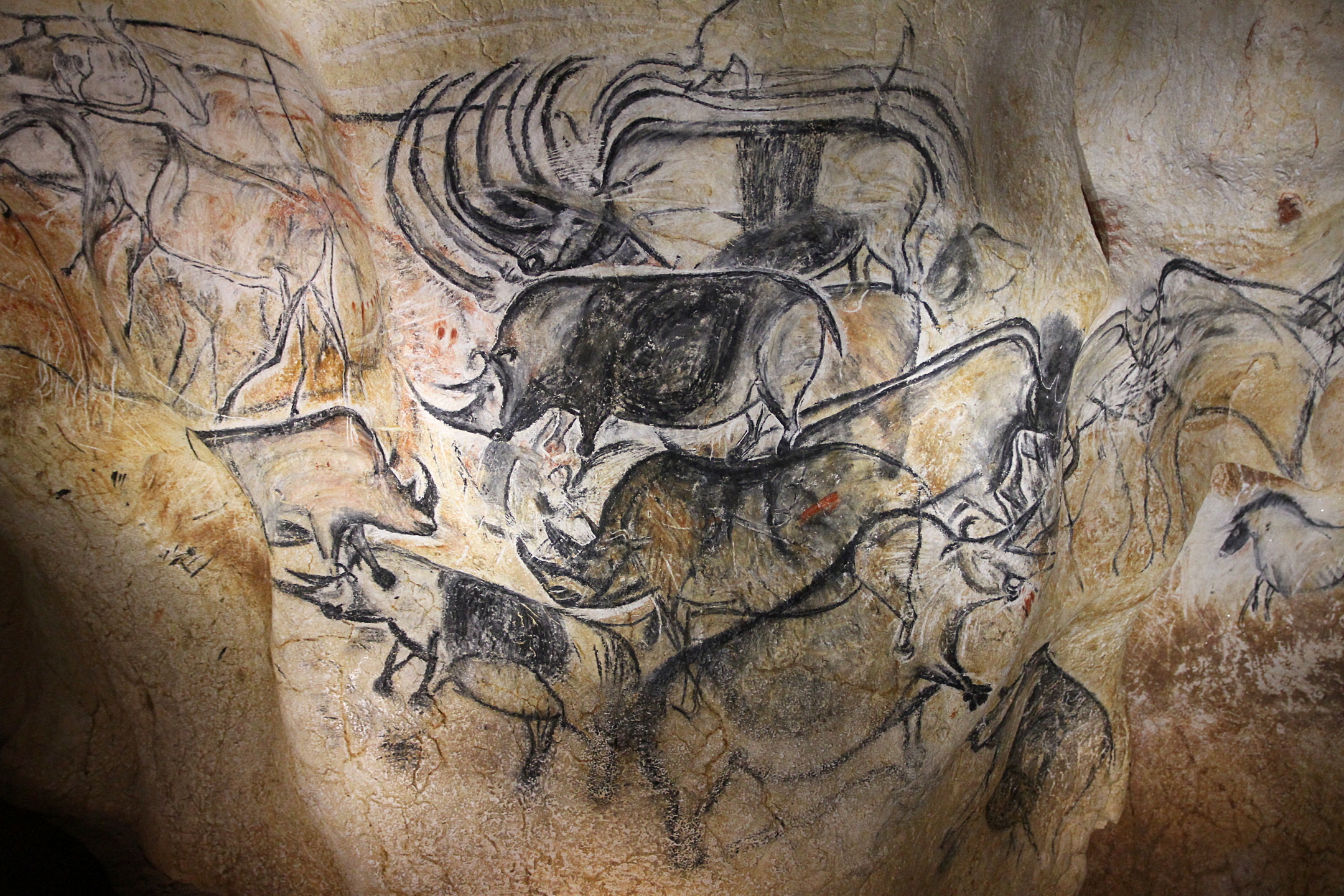
다른 그림들은 루피냐크 동굴과 라스코 동굴에서도 발견된다. 퐁드고옴 동굴의 한 그림은 머리 자세가 눈에 띄게 높고, 다른 그림들은 우랄 산맥의 카포바 동굴에서 붉은 색소로 그려졌다.[63] 일부 그림에는 창이나 화살에 맞은 코뿔소가 그려져 있어 인간의 사냥 대상이었음을 짐작하게 한다.[64]
또한, 체코 모라바에 있는 돌니베스토니체 유적지에서는 700개가 넘는 동물 조각상이 발견되었는데, 그중 많은 수가 털코뿔소 조각상이었다.[121][64]
6. 멸종
시베리아 북동부에서는 약 3만 년 전 인류가 진출한 이후 수천 년 동안 털코뿔소와 공존했던 것으로 보인다. 그러나 최종 빙기가 끝날 무렵, 개체 수가 급격히 감소하여 결국 멸종하였다.[88]
7. 냉동 표본
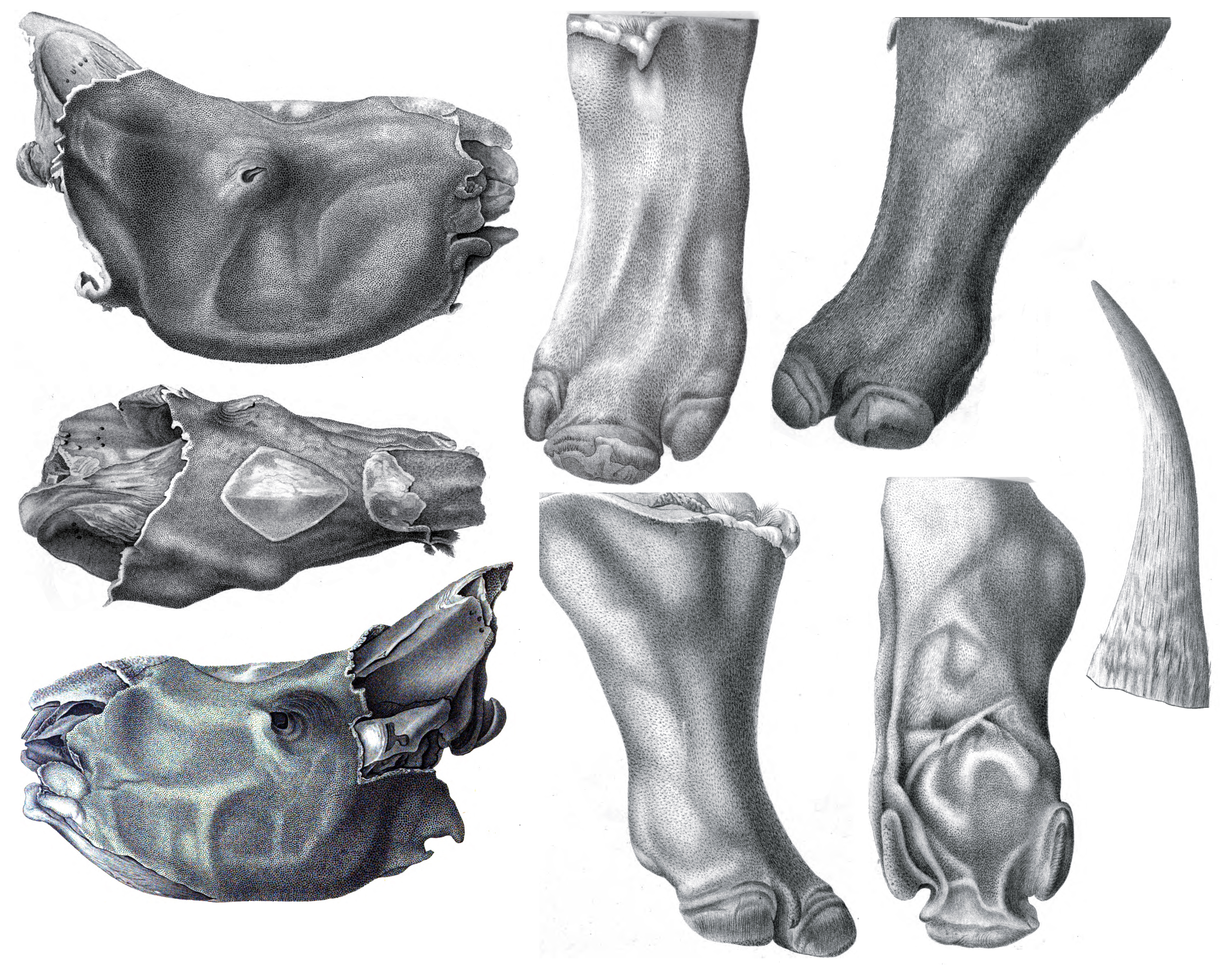
영구동토층 지역에서는 많은 털코뿔소 유해가 발견되었다. 1771년 시베리아 동부 빌류이 강에서 머리, 다리 두 개, 가죽이 처음 발견되어 상트페테르부르크의 쿤스트카메라로 보내졌다.[72] 이후 1877년 시베리아 상인이 야나 강의 지류에서 머리와 다리 하나를 발견했다.
1907년 10월, 당시 러시아 제국령이었던 스타루냐(현재 우크라이나)에서 광부들이 오조케라이트 채굴 중 매머드 사체를 발견했고, 한 달 후 그 아래 5m 지점에서 코뿔소 사체가 발견되었다.[73] 두 사체는 지에두시츠키 박물관으로 보내져 상세한 연구 결과가 발표되었고,[74] 여러 고생물학 저널과 교과서에 사진이 실리며 최초의 현대적인 털코뿔소 복원도의 기반이 되었다.[75] 현재 이 코뿔소는 매머드와 함께 리비우 국립 박물관에 소장되어 있다.[75] 이후 1929년 폴란드 예술 과학 아카데미는 스타루냐에 탐험대를 파견하여 세 구의 코뿔소 미라 유해를 추가로 발견했다.[76] 이 중 뿔과 털만 없어진 상태의 한 표본은 크라쿠프의 박물관(현 폴란드 과학 아카데미 자연사 박물관)으로 옮겨졌고, 얼마 후 이를 바탕으로 제작된 석고 주형은 현재 런던의 런던 자연사 박물관에 소장되어 있다.[77]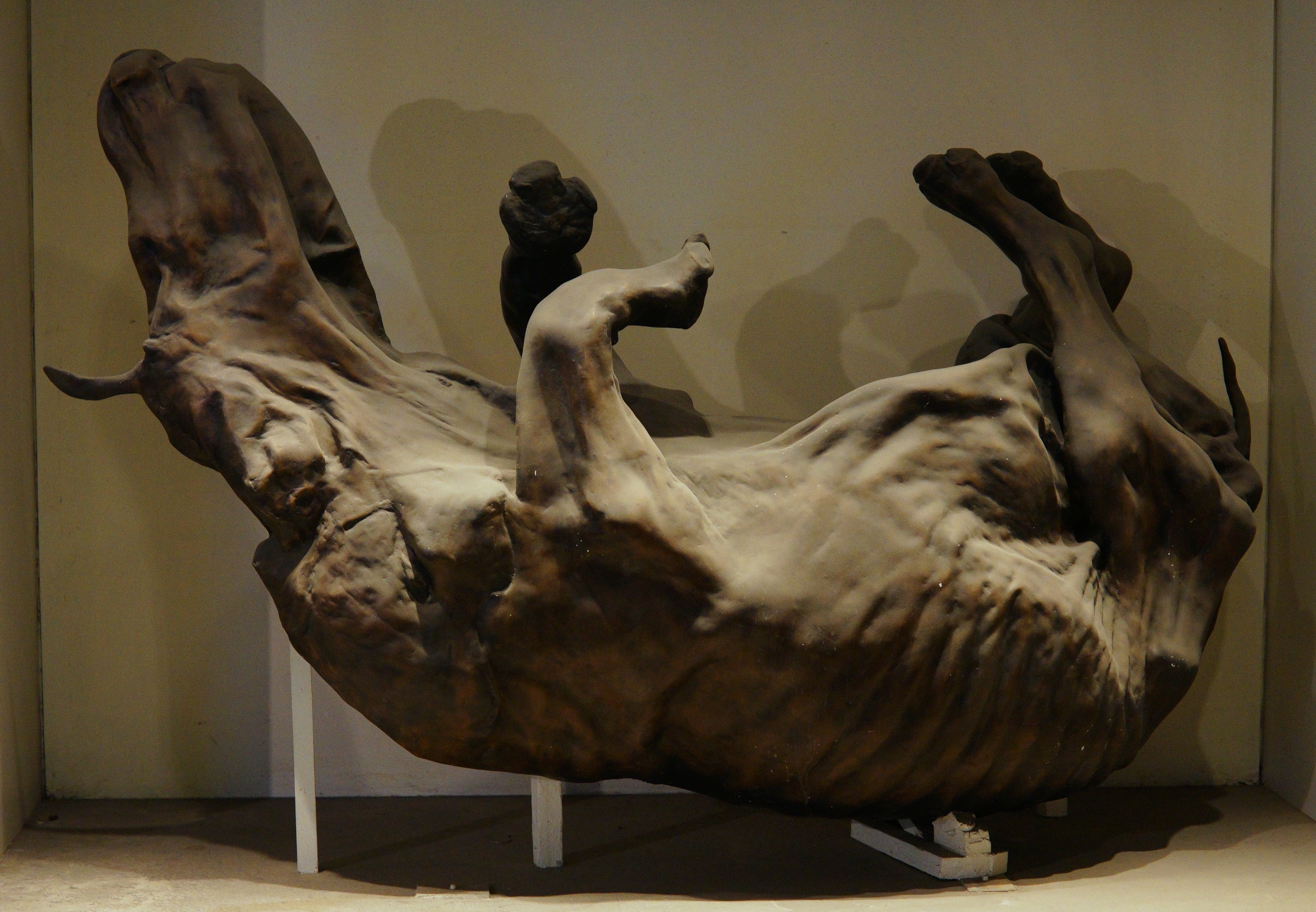
1972년에는 레나 강과 암가 강 사이의 추랍차에서 코뿔소의 두개골과 갈비뼈 조각이 발견되었고, 얼마 후 피부, 털, 위 내용물까지 보존된 완전한 골격이 발견되었다.[78] 1976년에는 수업 여행 중이던 학생들이 알단 강 좌안에서 약 2만 년 전의 것으로 추정되는 코뿔소 골격을 발견하여, 뿔 두 개가 달린 두개골, 척추, 갈비뼈, 사지뼈 등을 발굴했다.[79]
2007년에는 콜리마 강 하류에서 부분적인 코뿔소 사체가 발견되었는데, 위를 향한 자세로 보아 동물이 진흙에 빠져 가라앉았을 가능성이 제기되었다.[80] 다음 해인 2008년에는 추코치야 강에서 거의 완전한 골격이 발견되었고,[81] 같은 해 암가 근처 주민들이 미라화된 코뿔소 유해를 발견하여 이후 2년간 골반뼈, 꼬리뼈, 갈비뼈와 함께 발가락까지 온전한 앞다리와 뒷다리를 발굴했다.[82]
2014년 9월, 두 명의 사냥꾼이 러시아 야쿠티아 아비이스키군 세뮨랴흐 강 지류에서 미라화된 어린 코뿔소를 발견했다. 머리와 뿔, 털, 연조직이 잘 보존되어 있었으나, 영구동토층으로 덮이지 않았던 일부는 해동되어 다른 동물에게 먹힌 상태였다. 이 사체는 야쿠티아 과학 아카데미로 옮겨져 발견자 중 한 명의 이름을 따 "사샤"라고 명명되었다.[83] 치아 분석 결과, 이 새끼 코뿔소는 죽을 당시 약 7개월령이었던 것으로 추정된다.[84] 보존 상태가 매우 양호하여 과학자들은 DNA 분석을 진행할 수 있었다.[85][86]
2020년 8월에는 영구동토층이 녹으면서 2014년 발견 장소 근처에서 또 다른 코뿔소 사체가 발견되었다. 이 코뿔소는 3~4살 정도였으며, 익사한 것으로 추정된다. 대부분의 내장 기관이 온전하게 보존되어 있어 이 지역에서 발견된 동물 중 가장 잘 보존된 표본 중 하나로 평가받는다. 특히, 일반적으로 빠르게 분해되는 작은 코뿔소 뿔까지 보존되었다는 점에서 주목할 만하다.[87]
참조
[1]
논문
A Middle Pleistocene Coelodonta antiquitatis praecursor Guérin (1980) (Mammalia, Perissodactyla) from Les Rameaux, SW France, and a revised phylogeny of Coelodonta Bronn, 1831
https://hal.science/[...]
[2]
논문
Quaternary mammalian fossils from Hsintsai, South-Eastern part of Honan
http://en.cnki.com.c[...]
[3]
서적
The Mammoth and the Flood: An Attempt to Confront the Theory of Uniformity with the Facts of Recent Geology
https://books.google[...]
S. Low, Marston, Searle, & Rivington
[4]
논문
Horns, Tusks, and Flippers: the Evolution of Hoofed Mammals.
https://pdfs.semanti[...]
Aquatic Mammals Journal
2007-06-01
[5]
웹사이트
RRC: The Klagenfurt Lindwurm
http://www.rhinoreso[...]
2019-12-08
[6]
서적
Die Urwelt und die Fixsterne: eine Zugabe zu den Ansichten von der Nachtseite der Naturwissenschaft [The Primeval World and the Fixed Stars]
Arnoldischen Buchhandlung, Dresden
[7]
서적
Travels Through the Southern Provinces of the Russian Empire: In the Years 1793 and 1794
John Stockdale, Piccadilly
[8]
서적
A History of British Fossil Mammals, and Birds
J. Van Voorst
[9]
논문
The type material of Coelodonta antiquitatis (Blumenbach) (Mammalia: Perissodactyla: Rhinocerotidae) / Типовой материал Coelodonta antiquitatis (Blumenbach) (Mammalia: Perissodactyla: Rhinocerotidae) / Tipovoj material Coelodonta antiquitatis (Blumenbach) (Mammalia: Perissodactyla: Rhinocerotidae)
[10]
서적
Lethaea geognostica oder Abbildungen und Beschreibungen der für die Gebirgs-Formationen bezeichnendsten Versteinerungen
https://www.biodiver[...]
Stuttgart
[11]
논문
The rhinos from the Middle Pleistocene of Neumark-Nord (Saxony-Anhalt)
http://www.rhinoreso[...]
[12]
서적
Lebendige Eiszeit: Klima und Tierwelt im Wandel
Theiss
[13]
웹사이트
Siberia Surrenders Woolly Rhino Mysteries
https://www.rferl.or[...]
2012-12-06
[14]
논문
Ancient and modern genomes unravel the evolutionary history of the rhinoceros family
2021-08-24
[15]
논문
Reassessing the phylogeny of Quaternary Eurasian Rhinocerotidae
2023-01-19
[16]
논문
Out of Tibet: Pliocene Woolly Rhino Suggests High-Plateau Origin of Ice Age Megaherbivores
https://www.science.[...]
[17]
논문
A Middle Pleistocene Coelodonta antiquitatis praecursor (Mammalia, Perissodactyla) from Les Rameaux, SW France, and a revised phylogeny of Coelodonta
https://linkinghub.e[...]
2022-07
[18]
논문
Chronology and distribution of Central and Eastern European Pleistocene rhinoceroses (Perissodactyla, Rhinocerotidae) – A review
https://linkinghub.e[...]
2023-03
[19]
논문
Ancient mitogenomes reveal a high maternal genetic diversity of Pleistocene woolly rhinoceros in Northern China
2023-09-26
[20]
논문
Adaptation to graviportality in Rhinocerotoidea? An investigation through the long bone shape variation in their hindlimb
https://academic.oup[...]
2022-11-02
[21]
논문
When the woolly rhinoceroses roamed East Asia: a review of isotopic paleoecology of the genus Coelodonta from the Tibetan Plateau to northern Eurasia
2024-04-11
[22]
서적
Extinctions in Near Time. Causes, Contexts, and Consequences
https://books.google[...]
Springer US
1999-06-30
[23]
논문
Some specific morphological and ecological features of the fossil woolly rhinoceros (Coelodonta antiquitatis Blumenbach 1799)
[24]
논문
Horns of the woolly rhinoceros Coelodonta antiquitatis (Blumenbach, 1799) in the Ice Age Museum collection (Moscow, Russia)
https://www.scienced[...]
2012-03-26
[25]
논문
The earliest immigration of woolly rhinoceros (Coelodonta tologoijensis, Rhinocerotidae, Mammalia) into Europe and its adaptive evolution in Palaearctic cold stage mammal faunas
http://www.rhinoreso[...]
2008-11-01
[26]
논문
On nomenclatural problems concerning woolly rhinoceros Coelodonta antiquitatis (Blumenbach, 1799)
«Nauchnaya Kniga» Publishers, Saratov
[27]
논문
Extinction chronology of the woolly rhinoceros Coelodonta antiquitatis in the context of late Quaternary megafaunal extinctions in northern Eurasia
http://www.rhinoreso[...]
[28]
논문
Ethological inferences on Pleistocene rhinoceroses of Europe
Springer Science and Business Media LLC
[29]
논문
Dental ontogeny of the woolly rhinoceros Coelodonta antiquitatis (Blumenbach, 1799)
http://www.rhinoreso[...]
[30]
웹사이트
Почему вымер шерстистый носоро
http://www.official.[...]
2012-04-22
[31]
논문
Prey deposits and den sites of the Upper Pleistocene hyena Crocuta crocuta spelaea (Goldfuss, 1823) in horizontal and vertical caves of the Bohemian Karst (Czech Republic)
http://www.geology.c[...]
Czech Geological Survey, Prague
[32]
논문
Late Pleistocene Crocuta crocuta spelaea (Goldfuss, 1823) clans as prezewalski horse hunters and woolly rhinoceros scavengers at the open air commuting den and contemporary Neanderthal camp site Westeregeln (central Germany)
https://linkinghub.e[...]
2012-06
[33]
논문
Traumatic skull damages in the woolly rhinoceros, Coelodonta antiquitatis Blumenbach, 1799
http://www.rhinoreso[...]
[34]
논문
A skeleton of an injured Coelodonta antiquitatis (Blumenbach, 1807) from the Upper Pleistocene of north-western Germany
http://www.rhinoreso[...]
2008
[35]
Doctoral dissertation abstract
Woolly Rhinoceros: Morphology, Systematics and Geological Significance
http://www.rhinoreso[...]
Russian Mining Institute
1998
[36]
논문
The rhinoceroses from Neumark-Nord and their nutrition
http://www.rhinoreso[...]
Halle/Saale
[37]
학술지
A Middle Devensian woolly rhinoceros (Coelodonta antiquitatis) from Whitemoor Haye Quarry, Staffordshire (UK): palaeoenvironmental context and significance
http://www.rhinoreso[...]
Wiley
2012-12-18
[38]
학술지
Fifty thousand years of Arctic vegetation and megafaunal diet
https://eprints.soto[...]
2014
[39]
웹사이트
Woolly Mammoths and Rhinos Ate Flowers
https://www.livescie[...]
2014-02-05
[40]
논문
Stable isotope (C-13/C-12 and N-15/N-14) composition of the woolly rhinoceros ''Coelodonta antiquitatis'' horn suggests seasonal changes in the diet
[41]
학술지
Stable isotopic and mesowear reconstructions of paleodiet and habitat of the Middle and Late Pleistocene mammals in south-western Germany
https://www.scienced[...]
2020-01-01
[42]
학술지
Juvenile remains of the "woolly rhinoceros" ''Coelodonta antiquitatis'' (Blumenbach 1799) (Mammalia, Rhinocerotidae) from the Tomsk Priob'e area (southeast Western Siberia)
http://www.rhinoreso[...]
Elsevier BV
[43]
학술지
Extinct Eurasian rhinoceros Coelodonta and Stephanorhinus dental pathologies and tooth change modus
https://linkinghub.e[...]
2023-02-01
[44]
학술지
The origin of Eurasian Mammoth Faunas (Mammuthus–Coelodonta Faunal Complex)
http://www.rhinoreso[...]
2014-07-15
[45]
학술지
The Pleistocene easternmost distribution in Eurasia of the species associated with the Eemian ''Palaeoloxodon antiquus'' assemblage
Wiley
[46]
논문
Woolly rhinoceroses: On the history of the genus
[47]
학술지
Environmental conditions across Poland during the Eemian Interglacial reconstructed from vertebrate remains
https://geojournals.[...]
2023-09-28
[48]
논문
The History of Rhinocerotoidea
Oxford University Press, New York
[49]
학술지
Woolly rhino (''Coelodonta antiquitatis'') distribution in Northeast Asia
http://www.rhinoreso[...]
[50]
학술지
Eingeschleppte und benagte Knochenreste von ''Coelodonta antiquitatis'' (Blumenbach 1807) aus dem oberpleistozänen Fleckenhyänenhorst Perick-Höhlen im Nordsauerland (NW Deutschland) und Beitrag zur Taphonomie von Wollnashornknochen in Westfalen
http://www.rhinoreso[...]
[51]
논문
Comments on a cut-marked woolly rhino mandible from Zwolen
Warsaw, Institute of Archaeology and Ethnology, Polish Academy of Sciences
[52]
학술지
Ein mittelpaläolithisches Rentierlager bei Salzgitter-Lebenstedt.
[53]
학술지
''Coelodonta antiquitatis praecursor'' (Rhinocerotidae) du Pléistocène moyen final de l'aven de Romain-la-Roche (Doubs, France)
[54]
학술지
Die jungpleistozäne Säugetierfauna der Gudenushöhle (Niederösterreich).
[55]
학술지
Königsaue. Gliederung, Ökologie und mittelpaläolithische Funde der letzten Eiszeit.
[56]
서적
The Ancient Human Occupation of Britain
https://books.google[...]
Elsevier Science
[57]
논문
The faunal record of the Lower and Middle Palaeolithic of Europe: remarks on human interference
Leiden: University of Leiden
[58]
서적
The Killing Fields of Zwolén: A Middle Paleolithic Kill-butchery-site in Central Poland
Institute of Archaeology and Ethnology, Polish Academy of Sciences
[59]
학술지
Evidence from the Yana Palaeolithic site, Arctic Siberia, yields clues to the riddle of mammoth hunting
Elsevier BV
[60]
뉴스
13,300 year old spear made of woolly rhinoceros horn found on Arctic island
https://siberiantime[...]
[61]
서적
Journey Through the Ice Age
University of California Press
[62]
웹사이트
Fighting Rhino & Four Horses - The Cave Art Paintings of the Chauvet Cave
http://www.bradshawf[...]
[63]
웹사이트
Kapova Cave
https://www.donsmaps[...]
[64]
서적
The Nature of Paleolithic Art
https://books.google[...]
University of Chicago Press
[65]
학술지
52,000 years of woolly rhinoceros population dynamics reveal extinction mechanisms
2024-06-11
[66]
학술지
Late Pleistocene paleoecology and phylogeography of woolly rhinoceroses
2021-07
[67]
학술지
High incidence of cervical ribs indicates vulnerable condition in Late Pleistocene woolly rhinoceroses
2017-08-29
[68]
학술지
Pre-extinction Demographic Stability and Genomic Signatures of Adaptation in the Woolly Rhinoceros
https://linkinghub.e[...]
2020-10
[69]
학술지
Late Quaternary dynamics of Arctic biota from ancient environmental genomics
2021-10-20
[70]
학술지
When did mammoths go extinct?
2022-12-01
[71]
보고서
Mitochondrial genomes of Pleistocene megafauna retrieved from recent sediment layers of two Siberian lakes
https://elifescience[...]
elife
2023-09-01
[72]
웹사이트
Three Centuries of Hunting for Ice Age Mummies and the Prospect of De-Extinction
https://beta.capeia.[...]
2018-05-18
[73]
저널
Unique Quaternary environment for discoveries of woolly rhinoceroses in Starunia, fore-Carpathian region, Ukraine: Geochemical and geoelectric studies
2008-07-01
[74]
간행물
Wykopaliska staruńskie. Słoń mamut (Elephas primigenius Blum.) i nosorożec włochaty (Rhinoceros antiquitatis Blum. s. tichorhinus Fisch.) wraz z współczesną florą i fauną
Muzeum im. Dzieduszyckich we Lwowie
[75]
저널
The Starunia collections in the Natural History Museum of the National Academy of Sciences of Ukraine in Lviv
http://www.rhinoreso[...]
[76]
저널
The Starunia collections in the Institute of Systematics and Evolution of Animals, Polish Academy of Sciences in Kraków
AGHU University of Science and Technology Press
[77]
간행물
The second woolly rhinoceros (Coelodonta antiquitatis Blum.) from Starunia, Poland (Geology, Mineralogy, Flora and Fauna)
Classe des Sciences Mathématiques et Naturelles, Série B: Sciences Naturelles
[78]
서적
Mlekopitayushchie antropogena Yakutii (Mammals of the Anthropogene in Yakutia)
Yakut. Nauch. Tsentr Akad. Nauk SSSR
[79]
뉴스
Woolly Rhino Fossils Found
https://www.nytimes.[...]
1976-10-10
[80]
저널
Preliminary study of a mummified woolly rhinoceros from the lower reaches of the Kolyma River
http://www.rhinoreso[...]
[81]
저널
Estimation of individual age and season of death in woolly rhinoceros, Coelodonta antiquitatis (Blumenbach, 1799), from Sakha-Yakutia, Russia
2010-11-01
[82]
서적
Woolly rhinoceroses from Yakutia//evolution of life on the Earth
TML-Press
[83]
뉴스
Meet Sasha - the world's only baby woolly rhino
https://siberiantime[...]
[84]
뉴스
Lifelike again after 34,000 years, the world's only baby woolly rhino
https://siberiantime[...]
[85]
뉴스
Sasha, the world's only baby woolly rhino, is 34,000 years old, say scientists
https://siberiantime[...]
2019-12-23
[86]
저널
Hair microstructure of the first time found calf of woolly rhinoceros Coelodonta antiquitatis
http://www.rhinoreso[...]
[87]
웹사이트
Woolly rhino from Ice Age unearthed in Russian Arctic
https://www.bbc.co.u[...]
2020-12-30
[88]
웹사이트
「ケブカサイ」の絶滅、人間ではなく気候変動が原因か 研究
https://www.afpbb.co[...]
AFP
2020-08-14
[89]
서적
The Mammoth and the Flood: An Attempt to Confront the Theory of Uniformity with the Facts of Recent Geology
https://books.google[...]
S. Low, Marston, Searle, & Rivington
[90]
저널
Horns, Tusks, and Flippers: the Evolution of Hoofed Mammals
https://pdfs.semanti[...]
Aquatic Mammals Journal
2007-06-01
[91]
웹인용
RRC: The Klagenfurt Lindwurm
http://www.rhinoreso[...]
[92]
서적
Die Urwelt und die Fixsterne: eine Zugabe zu den Ansichten von der Nachtseite der Naturwissenschaft
Arnoldischen Buchhandlung
[93]
서적
Travels Through the Southern Provinces of the Russian Empire: In the Years 1793 and 1794
John Stockdale, Piccadilly
[94]
서적
A History of British Fossil Mammals, and Birds
https://archive.org/[...]
J. Van Voorst
[95]
서적
Woolly rhinoceroses from Yakutia//evolution of life on the Earth
TML-Press
[96]
간행물
The type material of Coelodonta antiquitatis (Blumenbach) (Mammalia: Perissodactyla: Rhinocerotidae) / Типовой материал Coelodonta antiquitatis (Blumenbach) (Mammalia: Perissodactyla: Rhinocerotidae) / Tipovoj material Coelodonta antiquitatis (Blumenbach) (Mammalia: Perissodactyla: Rhinocerotidae)
[97]
서적
Lethaea geognostica oder Abbildungen und Beschreibungen der für die Gebirgs-Formationen bezeichnendsten Versteinerungen
https://www.biodiver[...]
Stuttgart
[98]
저널
The rhinos from the Middle Pleistocene of Neumark-Nord (Saxony-Anhalt)
http://www.rhinoreso[...]
[99]
서적
Lebendige Eiszeit: Klima und Tierwelt im Wandel
Theiss
[100]
웹인용
Siberia Surrenders Woolly Rhino Mysteries
https://www.rferl.or[...]
2012-12-06
[101]
저널
Adaptation to graviportality in Rhinocerotoidea? An investigation through the long bone shape variation in their hindlimb
https://academic.oup[...]
2022-11-02
[102]
저널
When the woolly rhinoceroses roamed East Asia: a review of isotopic paleoecology of the genus Coelodonta from the Tibetan Plateau to northern Eurasia
2024-04-11
[103]
서적
Extinctions in Near Time. Causes, Contexts, and Consequences
https://books.google[...]
Springer US
1999-06-30
[104]
저널
Some specific morphological and ecological features of the fossil woolly rhinoceros (Coelodonta antiquitatis Blumenbach 1799)
[105]
저널
The morphology and paleobiological significance of the horns of Coelodonta antiquitatis (Mammalia: Rhinocerotidae)
[106]
저널
Woolly rhino discovery in the lower Kolyma River
http://www.rhinoreso[...]
2011-08-01
[107]
저널
Horns of the woolly rhinoceros Coelodonta antiquitatis (Blumenbach, 1799) in the Ice Age Museum collection (Moscow, Russia)
https://www.scienced[...]
2012-03-26
[108]
저널
The earliest immigration of woolly rhinoceros (''Coelodonta tologoijensis'', Rhinocerotidae, Mammalia) into Europe and its adaptive evolution in Palaearctic cold stage mammal faunas
http://www.rhinoreso[...]
2008-11-01
[109]
간행물
On nomenclatural problems concerning woolly rhinoceros ''Coelodonta antiquitatis'' (Blumenbach, 1799)
«Nauchnaya Kniga» Publishers
[110]
저널
Extinction chronology of the woolly rhinoceros ''Coelodonta antiquitatis'' in the context of late Quaternary megafaunal extinctions in northern Eurasia
http://www.rhinoreso[...]
[111]
저널
Dental ontogeny of the woolly rhinoceros ''Coelodonta antiquitatis'' (Blumenbach, 1799)
http://www.rhinoreso[...]
[112]
웹인용
Почему вымер шерстистый носоро
http://www.official.[...]
2012-04-22
[113]
저널
Prey deposits and den sites of the Upper Pleistocene hyena Crocuta crocuta spelaea (Goldfuss, 1823) in horizontal and vertical caves of the Bohemian Karst (Czech Republic)
http://www.geology.c[...]
2006
[114]
저널
Late Pleistocene Crocuta crocuta spelaea (Goldfuss, 1823) clans as prezewalski horse hunters and woolly rhinoceros scavengers at the open air commuting den and contemporary Neanderthal camp site Westeregeln (central Germany)
https://linkinghub.e[...]
2012-06
[115]
저널
Traumatic skull damages in the woolly rhinoceros, ''Coelodonta antiquitatis'' Blumenbach, 1799
http://www.rhinoreso[...]
[116]
저널
A skeleton of an injured ''Coelodonta antiquitatis'' (Blumenbach, 1807) from the Upper Pleistocene of north-western Germany
http://www.rhinoreso[...]
2008
[117]
Doctoral dissertation abstract
Woolly Rhinoceros: Morphology, Systematics and Geological Significance
http://www.rhinoreso[...]
Russian Mining Institute
1998
[118]
서적
The rhinoceroses from Neumark-Nord and their nutrition
http://www.rhinoreso[...]
Halle/Saale
[119]
저널
A Middle Devensian woolly rhinoceros (Coelodonta antiquitatis) from Whitemoor Haye Quarry, Staffordshire (UK): palaeoenvironmental context and significance
http://www.rhinoreso[...]
Wiley
2012-12-18
[120]
서적
Journey Through the Ice Age
https://archive.org/[...]
University of California Press
[121]
서적
The Nature of Paleolithic Art
https://books.google[...]
University of Chicago Press
본 사이트는 AI가 위키백과와 뉴스 기사,정부 간행물,학술 논문등을 바탕으로 정보를 가공하여 제공하는 백과사전형 서비스입니다.
모든 문서는 AI에 의해 자동 생성되며, CC BY-SA 4.0 라이선스에 따라 이용할 수 있습니다.
하지만, 위키백과나 뉴스 기사 자체에 오류, 부정확한 정보, 또는 가짜 뉴스가 포함될 수 있으며, AI는 이러한 내용을 완벽하게 걸러내지 못할 수 있습니다.
따라서 제공되는 정보에 일부 오류나 편향이 있을 수 있으므로, 중요한 정보는 반드시 다른 출처를 통해 교차 검증하시기 바랍니다.
문의하기 : help@durumis.com